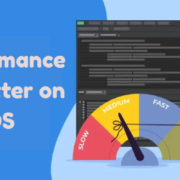What Is The Performance Of Flutter On IOS?
Flutter iOS is a robust framework for building high-performance, cross-platform mobile applications with a native-like experience. As Apple’s iOS ecosystem is known for its strict performance standards, many developers are curious about how Flutter performs on this platform. Join Flutter Training in Chennai to master the field and easily land a high-demand IT job. In this blog, we will explore the what is the performance of Flutter on IOS.
What Is Flutter?
- Flutter is an open-source UI toolkit developed by Google.
- It permits developers to create natively compiled applications for iOS, Android, and different platforms from a single codebase.
- Flutter uses the Dart programming language, known for its fast compilation and efficiency.
- The framework supplies a rich set of pre-designed widgets for crafting visually appealing and responsive UIs.
How Flutter Performs on iOS Devices
1. Near-Native Performance
- Flutter renders UI components using its Skia graphics engine, ensuring consistent performance across iOS devices. Also, consider a high-demand career in cloud tech, enroll in Google Cloud Training in Chennai.
- The rendering engine draws every pixel directly on the screen, bypassing native UI components, which results in near-native performance.
- This approach ensures that animations, transitions, and gestures feel smooth and responsive.
2. Consistent 60 FPS Rendering
- One of the hallmarks of Flutter’s performance is its ability to achieve 60 frames per second (FPS) on most iOS devices.
- For newer devices, Flutter can even achieve 120 FPS, ensuring fluid animations and scrolling.
- This is crucial for crafting a seamless user experience on high-refresh-rate iPhones and iPads.
3. Startup Time
- Flutter apps on iOS generally have slightly longer startup times compared to native apps.
- This is due to the need to load the Dart runtime and Flutter engine.
- However, optimisations like Ahead-of-Time (AOT) compilation help mitigate this, leading to faster startup performance compared to many hybrid frameworks.
- Discover Flutter, the future of mobile app development, to enhance and support your skills.
Factors Affecting Flutter’s iOS Performance
1. Platform-Specific Integrations
- Integrating Flutter with native iOS features can sometimes introduce performance overhead.
- Using platform channels to communicate between Dart and native Swift/Objective-C code may affect speed if not optimised.
2. App Size
- Flutter apps tend to have a bigger app binary size due to the inclusion of the Flutter engine.
- Developers can apply code obfuscation and tree-shaking techniques to minimise the final app size.
3. Memory Consumption
- Memory usage can be higher in Flutter apps compared to purely native iOS applications.
- Efficient state management and widget optimisation help in reducing memory overhead.
- Kickstart your career with Mobile App Development Courses in Chennai and learn to build innovative mobile applications.
Best Practices to Improve Flutter Performance on iOS
1. Use Efficient State Management
- Implementing effective state management techniques, such as Provider, Riverpod, or Bloc, can enhance app responsiveness.
2. Optimise Widget Trees
- Minimising deeply nested widgets and using const constructors where possible reduces unnecessary rebuilds.
3. Reduce Package Dependencies
- Only include essential Flutter packages to avoid bloated applications and ensure faster load times.
4. Leverage Skia Graphics Engine
- Utilise custom paint and canvas drawing to create high-performance graphics tailored for iOS devices.
5. Testing and Profiling
- Use tools like Flutter DevTools and Xcode Instruments to profile and debug performance bottlenecks specifically on iOS.
- Enhance your IT skills at the best Software Training Institute in Chennai, offering both online and offline classes with placement support.
Pros of Using Flutter for iOS Development
- Single codebase for multiple platforms.
- Rich UI and animations with consistent performance.
- Faster development and testing cycles.
- Growing community support and extensive libraries.
Cons of Using Flutter for iOS Development
- Slightly larger app size compared to the native version.
- Potential integration challenges with complex native APIs.
- Performance may lag slightly behind that of fully native apps in specific intensive tasks.
Flutter on iOS delivers impressive performance that closely rivals native applications. With smooth animations, high frame rates, and a growing ecosystem, Flutter is an excellent choice for developing iOS apps, particularly for businesses seeking cross-platform consistency and uniformity.
Also, Check: How Does Google Flutter Work

